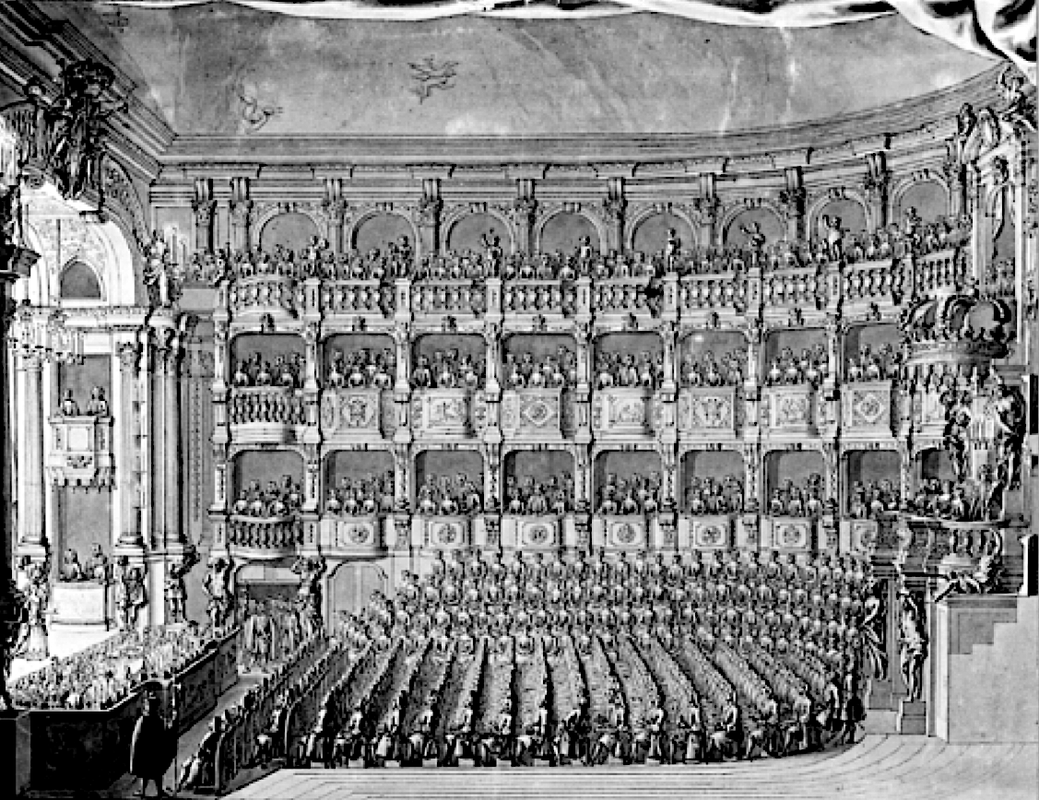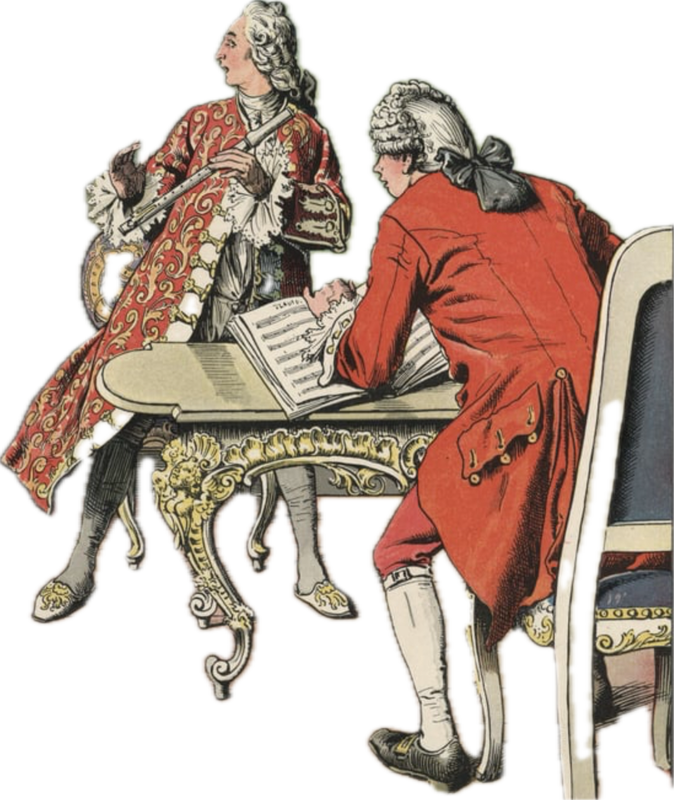|
One obvious piece of advice I can offer to the novice reader is to familiarize himself with Quantz's biography and keep it in mind when studying the "Versuch".
An indispensable tool is the autobiography that Quantz wrote in 1754 at the request of Friedrich Marpurg. This document was extensively summarised by Charles Burney in his famous 1775 Diary and constitutes a relevant part of Reilly's Introduction to his English translation. |
|
Today practical musicians (and particularly instrument teachers) experience a pleasant familiarity with the contents of "Versuch", much of which are still directly applicable in real-life situations. Unlike other musician-writers like Mattheson, Marpurg, or Carl Philipp Emanuel Bach, Quantz did not have a university academic background, so his own experience is the main source of his inspiration.
Burney had the privilege of meeting him a year before his death in 1773. Before portraying his biography, he describes him as an "industrious musician" showing an imposing appearance and possessing a vivid intelligence, whose existence had passed through "troublesome mazes." |
|
Quantz was born on January 30, 1697, in Oberscheden, a small village in the Hanover region. His father, Andreas, was a blacksmith, the profession to which his son was destined, despite his early strong inclination toward music making. His premature death in 1707, which Quantz does not hesitate to describe as "providential," led the young boy to be sent to Merseburg, to relatives who ran a company of Stadtpfeifer. These were professional musicians who performed in civil and religious events, as well as private celebrations, with a diverse repertoire of instrumental music in all the styles of the time, from French dances to traditional German music. In this guild Quantz had to learn to play, often by heart or improvising, a multitude of instruments, with the violin, oboe, and trumpet as his favourites.
|
|
Through the violin, he met the virtuosic music of Biber and Schmelzer, with the iconic Sonatas op. 5 of Corelli, and, above all, with the recent Venetian music of Albinoni, Marcello, and Vivaldi. The publication in 1711 of Vivaldi's concertos op. 3, L'Estro armonico, had caused a sensation in the European musical world, sparking passionate interest in composition within Quantz.
His fluctuating fortunes as a Stadtpfeifer gradually led him to Saxony. Its capital, Dresden, was one of the main European cultural centres, often referred to as the "Florence of the Elbe." |
|
In 1718, Quantz managed to join as an oboist the Dresden court entering the Polnische Capelle, a group of selected musicians who accompanied Augustus II during his periodic stays in Warsaw. Under the direction of the Italian Luigi Alberto Ristori, their repertoire included Italian intermezzi and serenades, along with chamber music by German and French composers such as Rébel and Campra. Despite its prestige, the salary was low, and the extended periods away from Dresden were uncomfortable. Furthermore, Quantz had to abandon his beloved violin to dedicate himself exclusively to the oboe. It was then that the aspiration to become a flutist matured to enter the Hofkapelle.
|
The transverse flute was still a relatively new instrument, popularized in France by the chamber musicians of Versailles, such as Hotteterre, Philidor, or De La Barre. In Dresden, the brilliant talent of Pierre Gabriel Buffardin had firmly established the figure of the professional flutist in the orchestra, ending the Versailles custom where oboists occasionally also played the flute. Seeing that a flutist position might become available, Quantz intensively studied this instrument under the guidance of Buffardin himself. Buffardin instructed him in its technical peculiarities, the original French repertoire, and, above all, its possibilities for the shining Italian concertante style.
|
|
Quantz decided to pour his aspirations as a composer into the flute, with the aim of creating a repertoire in line with the "modern" and "galant" style, shaped around the forms of Corelli's sonatas and Vivaldi's concertos, and in line with the expressive models of operatic singing and the violin. Alongside the violin, composition, and now the flute, Quantz also became interested in singing and the possibility of imitating it with the instrument in a "cantabile" style. This interest brought him closer to Georg Pisendel, who became his friend and mentor.
|
His first contact with Italian opera occurred in September 1719 during the celebrations for the wedding between Prince Frederick Augustus (future Augustus III) and Archduchess Maria Josepha of Austria. For the occasion, a large theatre, the largest in Germany, was built in Dresden by Daniel Pöppelmann. Its premiere was performed by the Venetian company of Antonio Lotti with his opera "Teofane", featuring the soprano Santa Stella Lotti and the famous castrato Senesino, among others. The event attracted personalities such as Telemann and Handel, who was looking for singers for his productions in London.
|
|
Between 1724 and 1727, Quantz was able to embark on a formative journey to Italy, France, and England, sponsored by the court for its young most talented musicians. Its detailed account occupies a significant portion of his autobiography and can be compared, in terms of places, people, interests, and critical judgments, to the famous musical diaries of Charles Burney. Quantz became known as a flutist and composer during this period and matured his ideas about style and interpretation.
His observations on the singers he heard in Italy and London are of particular interest, including Farinelli, Carestini, Anna Maria Strada, Vittoria Tesi, Faustina Bordoni, and Francesca Cuzzoni, among others. In addition to their documentary value, his systematic application of criteria such as timbre quality, intonation, musical and acting style, precision of ornamentation, diction, and suitability for the theatrical role is noteworthy. |
In Rome, Quantz received composition lessons from Francesco Gasparini, a prominent figure in Venetian opera and an internationally renowned contrapuntist.
He was also famous for having published in 1708 L'Armonico pratico al cembalo, which would be the most widely circulated accompanying treatise of the century.
In Naples, he met the venerable Alessandro Scarlatti, the castrato Farinelli at the beginning of his meteoric career, and, above all, struck up a friendship with Johann Adolph Hasse, who, along with Faustina Bordoni, would play a prominent role in the opera scene in Dresden.
In Paris, he encountered the vibrant community of virtuoso flutists, with Michel Blavet at the forefront. It was there that he developed the design of the flute model that bears his name, with the double key for E-flat and D-sharp as a distinctive feature.
In London, he met Pier Francesco Tosi, author of the famous singing treatise Opinioni de' cantori antichi e moderni, which had just been published the previous year. Quantz declined Handel's invitation to work on his operatic productions, motivated by his loyalty to the Saxon court. Fulfilling his commitments is a constant trait in his biography and likely one of the reasons for his voluntary confinement in the Prussian court during the last third of his life.
He was also famous for having published in 1708 L'Armonico pratico al cembalo, which would be the most widely circulated accompanying treatise of the century.
In Naples, he met the venerable Alessandro Scarlatti, the castrato Farinelli at the beginning of his meteoric career, and, above all, struck up a friendship with Johann Adolph Hasse, who, along with Faustina Bordoni, would play a prominent role in the opera scene in Dresden.
In Paris, he encountered the vibrant community of virtuoso flutists, with Michel Blavet at the forefront. It was there that he developed the design of the flute model that bears his name, with the double key for E-flat and D-sharp as a distinctive feature.
In London, he met Pier Francesco Tosi, author of the famous singing treatise Opinioni de' cantori antichi e moderni, which had just been published the previous year. Quantz declined Handel's invitation to work on his operatic productions, motivated by his loyalty to the Saxon court. Fulfilling his commitments is a constant trait in his biography and likely one of the reasons for his voluntary confinement in the Prussian court during the last third of his life.
In 1728, Quantz finally realized his dream of joining the "excellent company" of the virtuosos of the Hofkapelle, after securing the vacancy left by one of the flutists and finally sitting beside his mentor Buffardin under the direction of his friend Georg Pisendel. His fame as a virtuoso flutist was primarily forged during the two decades of his employment in the celebrated Hofkapelle of Dresden.
The flute was rapidly gaining popularity among amateurs, and the works dedicated to it by composers such as Bach, Telemann, Handel, Locatelli, Blavet, or Boismortier developed a new idiomatic language for the instrument.
The flute was rapidly gaining popularity among amateurs, and the works dedicated to it by composers such as Bach, Telemann, Handel, Locatelli, Blavet, or Boismortier developed a new idiomatic language for the instrument.
|
In February of that same year, 1728, Prince Frederick of Prussia visited the Dresden court with his father, King Frederick William. The musical splendour, the distinction of the performers, and the brilliance of Quantz and Buffardin with their preferred instrument decisively impacted the 16-year-old prince's heightened sensitivity. Within a few months, the Dresden court returned the visit to Berlin, bringing along, at Frederick's express request, their finest musical gems: the two flutists Quantz and Buffardin, the violinist Pisendel, and the lutenist Sigismund Leopold Weiss. From then on, Frederick would spare no effort to make music one of his daily routines and to elevate Berlin to the same musical status as Dresden.
This was the first of many stays in Berlin that Quantz would make in response to the prince's insistent requests that he remain by his side. Meanwhile, in 1734, Quantz officially debuted as a composer with the publication of his first collection of sonatas, dedicated to Augustus III, who had succeeded his father to the throne the previous year. In 1739, he also began making instruments according to his own design, with the second key to fix enharmonic differences between sharp and flat notes pairs. |
Quantz, not without turmoil, had to balance two loyalties. While attempting to fulfil his commitments in Dresden Hofkapelle, which was just in the peak of its musical splendour under the guidance of his friend Pisendel and the Hasse-Bordoni couple, he also tried to Frederick in creating his own private orchestra, persuading some of Dresden's talents to join his student's service. Moreover, Frederick, violently at odds with his father, the stern "sergeant king," pursued his passion in secret, at least until his marriage and subsequent move to the tranquillity of Rheinsberg. Here, the nucleus of a formidable group of musicians was formed, including the Benda brothers, Graun, and, later, none other than Carl Philipp Emanuel Bach, who accompanied the already legendary daily private concert. The repertoire consisted of music composed by Frederick himself and a growing list of concertos composed by Quantz.
|
|
The 1754 autobiography of Quantz concludes praising the "sensible, mixed, and appealing" Berlin music style, which he considers the culmination of musical taste improvement. We know that the last twenty years of his life were dedicated to supervising his royal student's evening concert and composing its huge repertoire. He occasionally participated in the lively intellectual atmosphere of the city, taught flute classes, and promoted the dissemination and reissue of his treatise.
It was on July 12, 1773, when death surprised him in Potsdam while he was finishing his last concert, the 300th on Frederick's famous list. Haydn had just premiered his Symphony "The Farewells," Mozart was seventeen years old, and Beethoven was only three. |
|
Resuming the whole picture, we can say that Quantz was an outstanding musician proficient at many instruments, becoming a virtuoso flutist in a first-class ensemble only after having gained a rich experience in all musical fields, from dance to opera. He was an experienced teacher, as soon as from his years as a professional Stadtpfeifer up to such a demanding and dedicated student as Frederick of Prussia. He was a prolific composer: his huge contribute to the flute repertoire can be only compared to Tartini’s one for the violin and D. Scarlatti’s for the keyboard. He was a fine flute maker, worried about its technical improvement. Finally, he was a fine and critical observer of his world, detailing it in his "Versuch" and Autobiography. |
Now that we have become acquainted with the author and his history, it’s time to dive into the book.
© Agostino Cirillo 2024


















